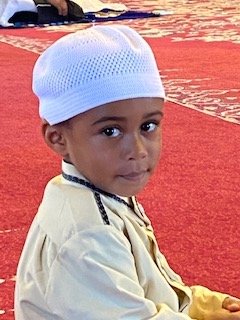HOW ‘MY KUFI AND ME’ CAME TO BE
I love kids! I love their imaginations. I love the way they explore and learn. I love their curiosity. I love their developing minds and personalities. Dress up and role play is an important developmental task that can foster communication and social skills. I am in awe of children and the things they do and say. I find myself being amused by their antics.
For example, I recently went to visit a family that arrived from Mauritania. The youngest child made my heart dance.
He was cute - like many children. He was short - like most two year olds. He was busy - not sitting still for more than two minutes. However, his gait is what tickled me. He walked with such confidence and maturity as his protruding belly led the way. I called him over to me and he gave me that, ‘Yeah, right’ look. When I asked him to share his drink, he raised his shoulder to his chin as if to say, ‘No way!’ I spent most of my visit trying to get him to be my friend. However, these things take time, so I resolved to try again on my next visit!
My latest book, My Kufi and Me, was born from a familiar encounter. It all started with this pandemic! I was approached to teach a beginner’s reading course online. I balked at the idea in my brain but my mouth said sure. It was not an easy task, but the students made it fun. They logged on every day eager and ready to learn. One day a student appeared on screen wearing a white kufi.
It was a bit oversized for his small head but nonetheless he wore it with style. I complimented him and continued with the lesson. The next day came and you guessed it - a different student appeared on screen wearing his kufi. Mr. Kufi from day one ran off screen to grab his. They both beamed with confidence and joy. They felt special. Day three came and another male student appeared on screen wearing a kufi and his sister wore a hijab. I wanted to screenshot their beautiful faces, but of course I did not.
I began to think about how I feel when I wear my hijab. It quickly identifies me as a Muslim woman. The world pretty much knows some basic things about me - I pray five times a day; I dress modestly; I don’t drink or do drugs; and. . . Yet, a Muslim boy is not known to the world unless he identifies himself as one. A male muslim living in the West is not easily recognizable unless he dons certain attire.
In muslim families that have both male and female children, something dynamic happens when they reach puberty. A young girl that adheres to the command of Allah swt, dons her hijab. However, it is not the same for young boys. His puberty is not marked by identifying attire. His puberty is marked by a crack in his voice, randomly protruding hairs on his face, or his new body scent.
‘Are there any boys that want to identify themselves as Muslim by their dress?’ I wondered. So the story took off from there. I imagined a little brother that admired his big sister so much that he too wanted to wear something that identified him as a Muslim. She covers her head. I can too! The main character in My Kufi and Me convinced his mom to order a kufi for him to wear. When it arrived, he and his kufi became inseparable.
For those of you that are thinking, ‘I wear a kufi or I know someone that does, but I or he is not a muslim.’ Correct! In some regions a kufi is a hat worn by Christians and Muslims alike. In some West African countries it is worn to symbolize status. For some, it is part of their cultural dress and does not identify one’s religion. Kufis have many different names and styles depending on the country or region that it is worn in.


